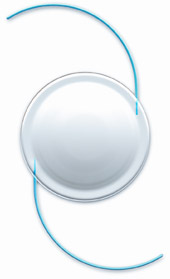It's True!!!
 The TECNIS Multifocal Lens (IOL) not only treats cataracts, but it also turns back the clock to restore much of your ability to see up close and at a distance. And, for many people who have worn glasses or contacts most of their lives, the TECNIS Multifocal Lens could mean independence from glasses for the first time. The TECNIS Multifocal Lens (IOL) not only treats cataracts, but it also turns back the clock to restore much of your ability to see up close and at a distance. And, for many people who have worn glasses or contacts most of their lives, the TECNIS Multifocal Lens could mean independence from glasses for the first time.
In fact, 94% of those who received the technology in the TECNIS Multifocal Lens reported wearing glasses either "never" or "occasionally." So if you have been diagnosed with cataracts, ask your doctor if you can resume your life with TECNIS.
How the TECNIS Multifocal Lens Improves Vision
The TECNIS Multifocal Lens is a clear, foldable implant made of a high refractive index acrylic material. In most cases, the entire procedure is performed through a micro-incision while the patient is fully awake. During the procedure, the natural lens is removed and the TECNIS Multifocal Lens replaces it.
The whole procedure usually takes 15 to 45 minutes. Vision is restored immediately in most cases; however, vision usually continues to improve in the weeks following the procedure.
A common side-effect may include halos or glare around bright lights. This varies from person to person and in most cases is more noticeable during the first few months after the procedure when your eyes are more sensitive. Also, some people are more likely to have difficulties with glare and halos, so ask your doctor to explain this possible condition to you before your procedure.
Keep in mind that lens implants have been in use for about 50 years to treat cataracts. Over 14.2 million cataract and lens implant procedures are now performed each year.
How age affects your eyes
As people get older, the natural lens in their eye usually deteriorates in one or two ways.
Presbyopia - In the condition called presbyopia, aging causes the eye's natural lens to become less flexible. This diminishes the eye's ability to switch its focus from one focal plane to another, as in from near to far and back again. This also usually becomes more noticeable as people find it more difficult to see or read things that are close. Bifocals have been a frequent solution to work around this problem.
Cataract - Cataracts are a visual impairment that often affects those in their 60's, 70's or 80's. With this condition, the natural lens in the eye starts to become cloudy or brown. As a result, the lens diffuses the light before it hits the retina, and vision becomes blurry or dark. If left untreated, cataracts can lead to blindness. The only treatment available is a surgical procedure. The good news it that this procedure has been performed over 50 million times around the world.
What makes the TECNIS Multifocal Lens so different?
The TECNIS Multifocal Lens has several features, which make it a vision solution to consider if you have been diagnosed with cataracts and especially if you are farsighted.
Five focusing zones for a full range of vision:
-
Innermost zone: Bright light/distance-dominant zone -- Supports bright/distance condition, such as driving in daylight, when pupils are constricted.
-
Second zone: Near-dominant zone -- Provides additional near vision in a broad range of moderate to low light conditions.
-
Third zone: Distance/Intermediate zone -- Supports good distance vision in moderate to low light conditions.
-
Fourth zone: Near-dominant zone -- Provides good near vision in a range of light conditions.
- Outermost zone: Low light/distance-dominant zone - Provides additional distance-dominant support in low light conditions, such as driving at night, when pupils are dilate
Balanced View OpticsTM Technology provides full-range vision
First, the TECNIS Multifocal Lens is a true multifocal IOL. That means that it literally has multiple focal points so you can see well at a variety of distances. It allows most people to see well anywhere, be it near, mid-distance or far.
Specially proportioned for better vision - day and night
The TECNIS Multifocal Lens has uniquely proportioned visual zones that provide it with its major advantage. Each TECNIS Multifocal Lens is divided into five different zones with each zone designed for different light and focal distances. Unlike other earlier multifocal lens designs, the TECNIS Multifocal Lens has proportioned the size of its zones to provide for good vision in a range of light conditions. For instance, some zones have been designed to offer greater low light/distance vision support during night driving.
How to know if TECNIS Multifocal Lens if right for you
If you are diagnosed with cataracts and are experiencing one or more of the following symptoms, you may be a candidate for the TECNIS Multifocal Lens:
-
Difficulty reading
-
Difficulty seeing close objects
-
Difficulty seeing to drive, especially at night
-
Changing glasses prescriptions
-
Needing bifocals
To learn more, ask your ophthalmologist about how TECNIS Multifocal Lens may be able to improve your vision and increase your quality of life. As with any procedure, there are risks and benefits. Your doctor will review all important safety issues with you.
:: TECNIS Multifocal Lens FAQ's
|





